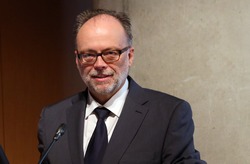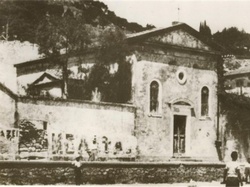The following is an article published by Theo Dirix in his blog. He is one of the Vesalius Continuum project members and a contributor to this website. Theo Dirixis an author and a taphophile. He has successively held the office of Consul in Embassies of Belgium in Tanzania, Saudi Arabia, Jordan, Canada, the United Arab Emirates and, since 2011, Greece. His current posting is in Kopenhagen, Denmark Before 1989, he worked for the Flemish Radio 3 and commented on (mainly Moroccan) literature. He is constantly writing travel stories of his visits to cemeteries and graves. He is also the author of the book "In Search of Andreas Vesalius: The Quest for the Lost Grave".
|
Isn’t it amazing how much we know about a scientist and physician who lived five hundred years ago, I am referring, of course, to the prominent figure of Andreas Vesalius (1514-1564)? (2) After a jump start in academia in Italy, the Flemish anatomist made a sudden career move and became the family physician of Charles V, Emperor of the Holy Roman Empire, and to his successor Philip II and their powerful entourage in Spain. His brilliant early work, De Humani Corporis Fabrica Libri Septem, a milestone in the transition to empiric research, which has a revolutionary pedagogical and artistic approach, still inspires. Isn’t it even more amazing that new discoveries about this giant and his achievements steadily continue to surface?(3) Most amazing, though, is that several hoaxes, mainly about his final months and days, doggedly survive.(4) Where is that undeniable proof that he ever ran into the otherwise so well documented inquisition?(5) Vesalius left Spain as a pious pilgrim. A laissez-passer [safe passage document] by Philip II and letters from the Spanish Embassy in Venice are conserved in archives in Spain. Even the thanking note by the Custodian of the Holy Places in Jerusalem, which Vesalius was to hand over to Philip II, reached its destination.(6) That unequivocally refutes the other obstinate prank that a shipwreck during his return was the cause of his death. Some now argue that scurvy may have been the cause; Omer Steeno, Maurits Biesbrouck and Theodoor Goddeeris point in the direction of general fatigue.(7) Obviously, only the discovery of his remains will help determine why he collapsed on the quay of Zakynthos, then a Venetian colony, as described in a recently rediscovered eyewitness report.(8) He was buried in the local catholic church of Santa Maria delle Grazie. Several Jerusalem pilgrims have indeed described his epitaph. Unfortunately, the church has disappeared. During its history, it was sacked, abandoned, damaged and finally, after major earthquake in 1953, bulldozed into the sea. |
|
|
| In view of the quincentenary of the anatomist, medical artist Pascale Pollier, hoping to reconstruct his face from his cranium, started a romantic quest for his remains. Under the impetus of the author and the Embassy of Belgium in Athens, archaeologists have been involved: Prof. Jan Driessen, Université Catholique de Louvain (UCL) and Director of the Belgian School in Athens, EBSA, and Apostolos Sarris, Deputy Director of the Institute for Mediterranean Studies - Foundation for Research and Technology, Hellas (IMS-FORTH).
In 2014, Dr. Sylviane Déderix (UCL/IMS-FORTH) checked the presumed location of the church through the spatial analysis of a Geographical Information System (GIS). With that digital tool, she displayed, corrected and analysed historical maps on modern cartographic data. The result confirms that the ruins of the Santa Maria delle Grazie and its annexes are to be found to the northwest of the intersection of Kolyva Street and Kolokotroni Street, partly below the asphalt and partly under private property of emergency lodgings, which date from the ’53 earthquake, and partly under a fairly new construction. To enrich the GIS of the first phase, a geophysical approach of anomalies under the surface should now follow. In this urban environment only non-destructive methods like ground penetrating radar (GPR) and electrical resistivity tomography (ERT) can be carried out. With the necessary permissions and funding, a team of researchers could be deployed to collect and process such data. If these are conclusive, a third phase of small scale excavations in search of remains may follow. To top up personal investments, Vesalius Continuum(9) has launched a crowd funding campaign to sponsor the second phase. If you wish to contribute to finding the real cause of Vesalius’s death and help Pascalle Pollier reconstruct the face of a genius whose legacy survives to this very day, visit: www.gofundme.com/VesaliusContinuum Personal note: Click on the following link to collaborate with this incredible quest. I already did. Dr. Miranda Notes and Sources:
|
||
| Back to MTD Main Page | Subscribe to MTD | |

